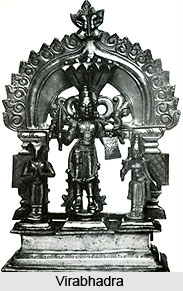 Virabhadra is a deity, who is a form of Shiva. Lord Shiva created him to act as his attendant in his quarrel with Daksha. Many versions of this animosity are available in various texts such as in the Kurma Varaba and Bhagavata Puranas as well as in several others. The link of Virabhadra with Vishnu is also available in some texts.
Virabhadra is a deity, who is a form of Shiva. Lord Shiva created him to act as his attendant in his quarrel with Daksha. Many versions of this animosity are available in various texts such as in the Kurma Varaba and Bhagavata Puranas as well as in several others. The link of Virabhadra with Vishnu is also available in some texts.
In some texts, Virabhadra holds a sword and shield in his two front hands and an arrow (left) and bow in his two backhands. He has a garland of skulls and wears sandals and has an angry expression on his face. The right hands of Virabhadra are shown in anjali mudra in which stands Daksha, a complex deity who first appears in the Rig Veda.
According to a mythological story, Daksha was volatile and aggressive. Once he offended Shiva by not inviting him to attend a `Yagna` that Daksha had arranged to perform. Shiva married one of Daksha`s daughters named `Sati`. She wanted to attend the Yagna but Shiva told her of the enmity between him and Daksha and advised her not to go. But, she went to Daksha`s house to attend the ceremony. When she went there, her father Daksha insulted her husband Shiva very badly and humiliated her. She could not bear the insult and committed suicide by jumping into the pit containing the sacrificial fire. Shiva was angered by this Shiva and created Virabhadra as a form of him. He provided him an army and sent him to punish Daksha. Virabhadra did the destruction very successfully by cutting off Daksha`s head in the battle.
The other gods got afraid by the loss of Daksha`s reputation in ritual procedure, which might obstruct with the effectiveness of their own sacrifices. Hence, they begged Lord Shiva to bring Daksha back to life. Shiva agreed to do so but Daksha`s head cut by Virbhadra could not be found. Then, Brahma substituted the head of the goat that had been cut off in the ritual sacrifice.



















